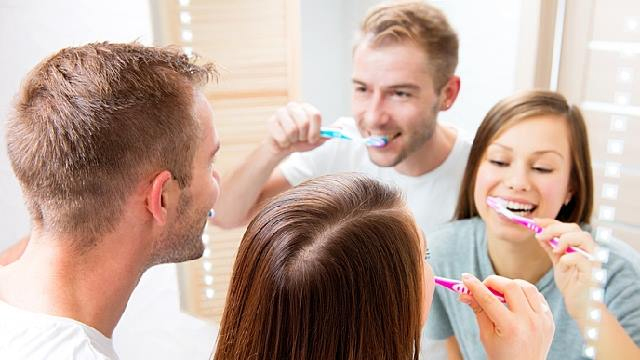
11 Oct 5 Simple Rules For Brushing Your Teeth

There’s nothing like that feeling after brushing your teeth. We run our tongue over the smooth enamel and breathe deep to enjoy that fresh mint taste. Brushing your teeth is an important part of dental hygiene, but did you know there is a technique to proper brushing? These 5 simple rules can help your teeth and gums stay healthy.
Rule #1: Brush 2 x 2
Brush 2 times per day for 2 minutes each time. Once a day brushing is not enough to prevent harmful bacteria and plaque build-up. Two minutes is the recommended time needed to effectively clean your entire mouth. Extensive and frequent brushing for more than 3 times per day can cause early wear on the enamel, called ‘enamel abrasion’. Excessive brushing can also cause premature receding of the gums.
Rule #2: Be Gentle
 You may think the harder the bristles the better the clean, right? Wrong. Tougher is not better especially when it comes to your teeth. Choose a soft-bristle brush to clean your teeth without causing harm to the root area or gums.
You may think the harder the bristles the better the clean, right? Wrong. Tougher is not better especially when it comes to your teeth. Choose a soft-bristle brush to clean your teeth without causing harm to the root area or gums.
Place the toothbrush sideways against your teeth and tilt the brush so the bristles are at a 45-degree angle while pointing at your gums. Move the brush back and forth or use light circular motions using short strokes and repeat for the insides and outsides of every tooth.
For some patients, an electric toothbrush may be a better solution. Patients with dexterity or compliance issues may benefit from the use of an electric toothbrush over the manual type. Please be aware that not all of manual or electric toothbrushes are equal and your dentist will recommend the best choice for your individual needs.
Rule #3: Don’t Forget the Tongue
Brushing your teeth includes cleaning your entire mouth: gums, the roof of mouth and tongue. The tongue comes into contact with all that we put into our mouth and can become a breeding ground for bacteria, causing everything from infection to illness to bad breath. There are tools available to clean your tongue but your toothbrush works just as well. As with your teeth, gently is better. Remember, this is a mild cleaning, not a scrub as brushing too aggressively can cause irritation or damage to the tongue.
Rule #4: Floss After Brushing

Many of us wait to floss our teeth until the day before our dental appointment. Flossing removes food particles the toothbrush cannot reach and it is an important part of dental hygiene. Regular flossing helps remove bacteria and plays a role in the prevention of plaque. Once plaque builds up on your teeth it can only be removed by your dentist. Floss once per day as part of your evening routine.
Rule #5: Out with the Old in with the New
When the bristles on your toothbrush start to fray and bend outward, it’s an overdue sign to throw it in the garbage. Replace your toothbrush every 3 months for effective and healthy cleaning. This includes electric toothbrush heads. It is also a good idea to replace your toothbrush if you have been sick. Buying toothbrushes in bulk make it easy to follow this guideline and may save money.
Along with regular 6-month check-ups, these simple tips will ensure the health of your mouth which also affects the overall health of your body. If your gums are hurting or bleeding or you notice sensitivity while brushing or eating, schedule an appointment today. We use our mouth to talk, eat, drink, and smile. Give it the attention it deserves.
“We Love to See You Smile!”
Imperialdentalcenter.com

